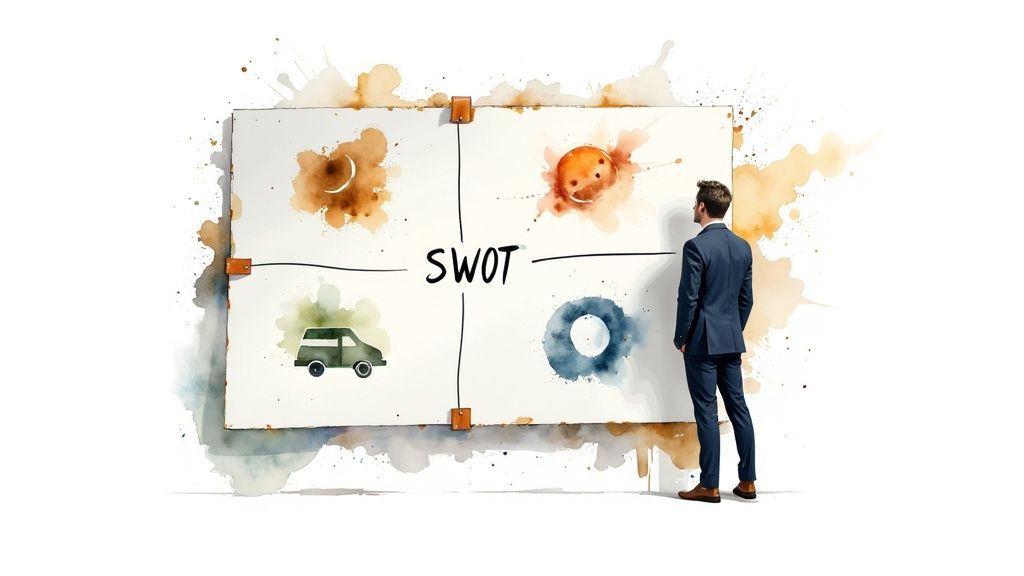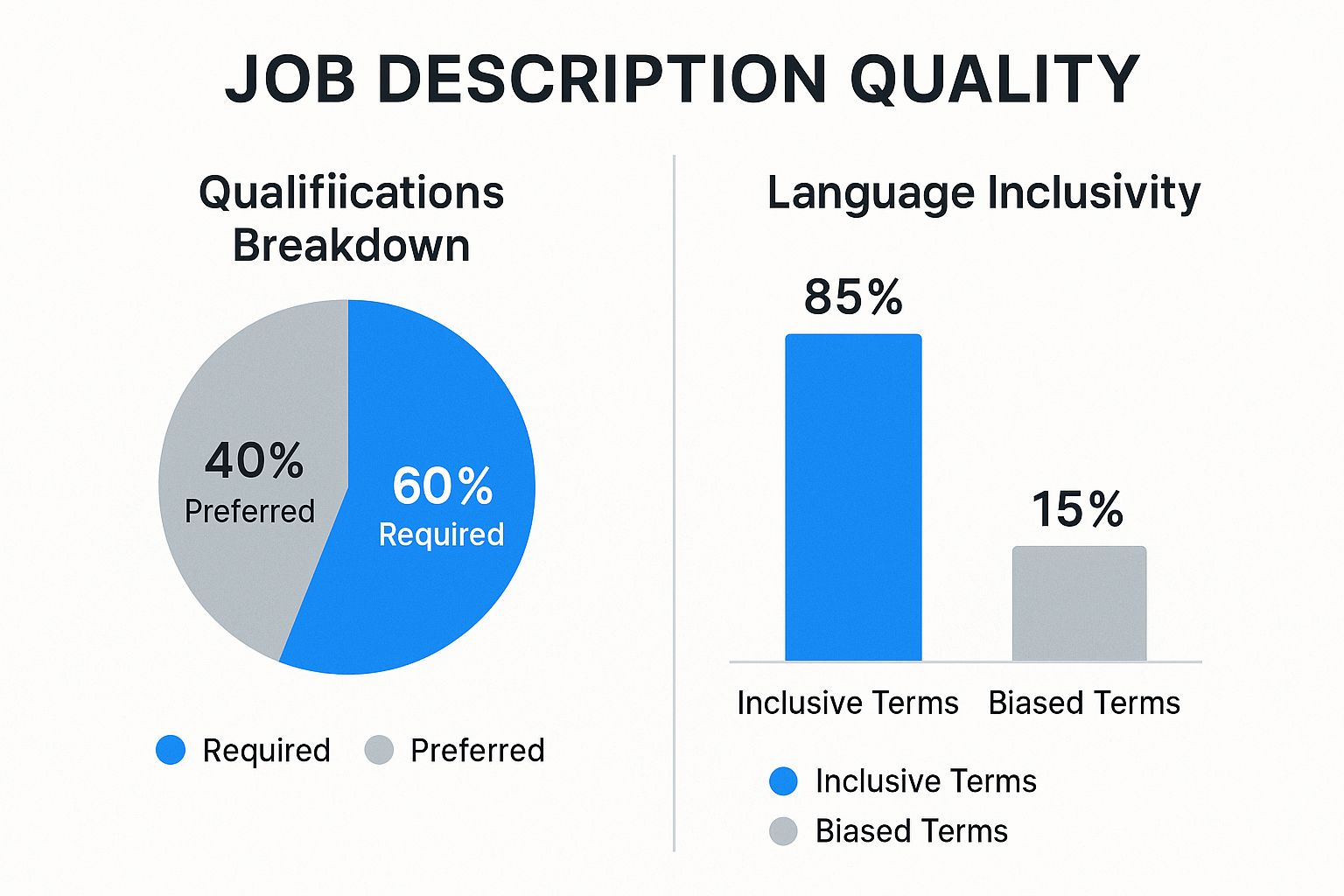8 Powerful ChatGPT Prompts for Business to Use in 2025

In today's competitive environment, generative AI isn't just a novelty; it's a fundamental business tool. Platforms like ChatGPT offer powerful capabilities to accelerate growth, streamline operations, and boost creativity, but unlocking their full potential requires a specific skill: effective prompting. The quality of your AI-generated output is directly proportional to the quality of your input. Mediocre prompts lead to mediocre results, while strategically crafted prompts can deliver exceptional value.
This article moves beyond generic advice to provide a strategic playbook of powerful, tested ChatGPT prompts for business. We've curated detailed examples across key functions like marketing, sales, operations, and customer service. Each prompt is broken down into its core components to give you a replicable framework for success:
- The Prompt: The exact input to use.
- Strategic Analysis: A breakdown of why it works.
- Actionable Takeaways: Quick tips to adapt and apply it immediately.
This hands-on approach is designed to help you integrate advanced AI into your workflows today. The increasing importance of this skill is underscored by the rise of specialized prompting companies, which highlights the growing demand for expertly engineered AI instructions. By mastering the prompts in this guide, you will learn to transform ChatGPT from a simple tool into a sophisticated assistant, capable of generating strategic plans, compelling marketing copy, and insightful data analysis. Let's dive into the examples that will help you unlock new levels of productivity and innovation.
1. Strategic Business Planning Assistant
Leveraging ChatGPT as a strategic business planning assistant involves using a comprehensive prompt to transform the AI into a virtual consultant. This approach democratizes access to high-level strategic analysis, allowing businesses to outline long-term goals, assess market dynamics, and identify growth opportunities without the high cost of traditional consulting firms. By feeding the AI detailed information about your company, market, and competitors, you can generate sophisticated, data-driven strategic frameworks.

This method is particularly valuable for startups developing their initial three-year growth plan, small businesses needing to pivot during economic shifts, or established companies exploring expansion into new territories. It essentially provides a structured thinking partner to help you navigate complex business challenges.
Why It's Effective
The power of this ChatGPT prompt for business lies in its ability to synthesize vast amounts of information and apply established business frameworks like SWOT (Strengths, Weaknesses, Opportunities, Threats) or PESTLE (Political, Economic, Social, Technological, Legal, Environmental) analysis to your specific context. It helps you identify blind spots and uncover insights you might have missed.
Strategic Insight: Use ChatGPT to role-play as a "devil's advocate" or a specific competitor to pressure-test your strategy. Ask it to find flaws, potential risks, and counterarguments to your core assumptions.
Actionable Tips for Implementation
To get the most out of your strategic planning sessions with ChatGPT, follow these best practices:
- Provide Rich Context: The quality of the output directly depends on the quality of your input. Include details about your company’s mission, financials, team skills, target audience, and competitive landscape.
- Break Down the Plan: Don't ask for a complete 5-year plan in one go. Structure your requests into distinct phases, such as short-term (0-12 months), medium-term (1-3 years), and long-term (3-5 years).
- Request Measurable Metrics: Insist on Key Performance Indicators (KPIs) and measurable outcomes for each strategic objective. Ask, "What specific metrics should we track to measure the success of this initiative?"
- Iterate and Refine: Treat the initial output as a first draft. Use follow-up prompts to dig deeper, ask for clarifications, and refine specific sections of the plan based on your expertise and intuition.
2. Customer Service Response Generator
Utilizing ChatGPT as a customer service response generator allows businesses to craft empathetic, professional, and on-brand replies at scale. This technique involves creating a detailed prompt that equips the AI with your company's specific voice, policies, and communication style, transforming it into a highly efficient customer support agent. It's an indispensable tool for managing high volumes of customer inquiries across email, live chat, and social media, ensuring every customer receives a timely and consistent response.
This approach is perfect for e-commerce stores handling shipping delay questions, SaaS companies that need to explain technical features, or hospitality businesses personalizing booking confirmations. It empowers support teams to focus on complex issues by automating the initial drafting of common responses, drastically improving efficiency and customer satisfaction.
Why It's Effective
The strength of this ChatGPT prompt for business comes from its ability to absorb and replicate your unique brand persona and operational rules. Instead of generic, robotic replies, it generates nuanced responses that align with your company's values, whether that's playful and friendly or formal and reassuring. This ensures a consistent customer experience, which is crucial for building trust and loyalty.
Strategic Insight: Use ChatGPT to analyze customer sentiment from an inquiry before drafting a response. Include this in your prompt: "First, analyze the sentiment of the following customer email (frustrated, confused, pleased). Then, draft a response that directly addresses their emotional state while resolving their issue."
Actionable Tips for Implementation
To generate high-quality customer service responses, implement these best practices:
- Create a Brand Voice Guide: The prompt's effectiveness hinges on clear instructions. Provide ChatGPT with a mini-guide detailing your tone (e.g., empathetic, professional, witty), key phrases to use or avoid, and formatting rules.
- Include Specific Policies: For accurate replies, embed relevant company policies directly into the prompt. Include details about your return policy, shipping times, or service level agreements (SLAs).
- Provide "Good" Examples: Fine-tune the AI's output by including a few examples of excellent past customer responses. This helps it learn the desired structure, tone, and level of detail by example.
- Segment by Inquiry Type: Develop separate, specialized prompts for different categories of inquiries like complaints, technical support, billing questions, and positive feedback. This ensures the response is highly relevant and effective for each specific scenario.
3. Marketing Copy and Content Creator
Employing ChatGPT as a marketing copy and content creator involves using a detailed prompt framework to generate persuasive and brand-aligned text across numerous channels. This powerful application transforms the AI into a tireless junior copywriter, capable of producing everything from social media updates and email campaigns to blog posts and ad copy. It helps businesses scale their content production, maintain a consistent voice, and drive conversions without a massive in-house team.

This approach is a game-changer for digital marketing agencies needing to create social media calendars in hours, e-commerce stores generating unique descriptions for thousands of products, and startups building out their entire website copy on a tight budget. It effectively democratizes high-quality copywriting, enabling any business to communicate its value proposition clearly and compellingly.
Why It's Effective
The strength of this chatgpt prompt for business is its ability to rapidly adapt to different formats, tones, and marketing frameworks like AIDA (Attention, Interest, Desire, Action) or PAS (Problem, Agitate, Solution). By providing specific inputs about your target audience's pain points and desired outcomes, you can generate content that resonates deeply and encourages action. It streamlines one of the most time-intensive aspects of marketing. For more inspiration, you can find a wide range of marketing-focused prompts for ChatGPT.
Strategic Insight: Create a "Brand Voice & Style Guide" prompt that you use at the beginning of every content creation session. Include your company's mission, core values, target audience demographics, tone (e.g., professional yet witty), and a list of words to use or avoid. This ensures unwavering consistency.
Actionable Tips for Implementation
To generate marketing copy that truly converts, follow these best practices:
- Be Hyper-Specific: Clearly define the format (e.g., LinkedIn post, abandoned cart email), word count, and desired tone. The more specific your request, the better the result.
- Provide Core Messaging: Include your unique value proposition, key differentiators, and the primary call-to-action (CTA). Tell the AI what makes you different and what you want the reader to do.
- Request Variations: Ask for multiple headline options, CTA variations, or opening hooks. This allows you to A/B test different elements to see what performs best with your audience.
- Incorporate Keywords Naturally: Provide a list of SEO keywords and instruct ChatGPT to weave them into the content, such as a blog post or product description, in a way that feels natural and adds value to the reader.
4. Data Analysis and Insights Interpreter
This advanced prompt transforms ChatGPT into a business intelligence analyst capable of interpreting data, identifying trends, and providing actionable recommendations. While the AI cannot directly access live databases or spreadsheets, this framework allows users to input data summaries, metrics, or paste data sets for sophisticated analysis. This democratizes data interpretation, empowering businesses without dedicated analytics resources to make data-driven decisions.

This approach is highly effective for e-commerce managers analyzing monthly sales figures to spot top-performing products, marketing teams interpreting campaign metrics to optimize ad spend, or SaaS companies analyzing churn data to find at-risk customers. It acts as an on-demand analyst, translating raw numbers into a clear business narrative.
Why It's Effective
The strength of this ChatGPT prompt for business comes from its ability to process numerical and categorical data and identify patterns, correlations, and anomalies that might not be immediately obvious. It can perform calculations like percentage change, year-over-year growth, and customer segmentation on the provided data, turning a simple spreadsheet into a source of strategic insight. By acting as an analytical operator, it unlocks deeper understanding from existing information. To explore this concept further, you can learn more about OpenAI's Operator on PromptDen.
Strategic Insight: Ask ChatGPT to generate hypotheses based on the data. For instance, "Given this decline in user engagement, what are three potential underlying causes we should investigate?" This moves beyond simple observation to proactive problem-solving.
Actionable Tips for Implementation
To maximize the accuracy and utility of your data analysis with ChatGPT, apply these best practices:
- Provide Clear Context: Start your prompt by explaining what the data represents. For example, "This data shows monthly active users for our SaaS product from January to June."
- Define Your Goal: State the specific business questions you need to answer. Ask, "Which marketing channel has the highest conversion rate?" instead of just "Analyze this data."
- Request Ranked Insights: Ask ChatGPT to prioritize its findings by potential business impact. This helps you focus on what truly matters instead of getting lost in minor details.
- Demand Actionable Steps: Push beyond observations. Follow up with, "Based on the insight that Product B is underperforming, suggest three specific actions we could take to improve its sales."
5. Meeting Agenda and Minutes Generator
Utilizing ChatGPT as a meeting agenda and minutes generator is a powerful productivity hack that streamlines one of the most common business activities. This prompt transforms the AI into an administrative assistant, capable of creating structured agendas to guide discussions and then summarizing those discussions into concise, actionable minutes. This ensures meetings are focused, efficient, and result in clear, documented outcomes.
This application is crucial for teams in remote or hybrid settings where clear documentation is essential for alignment and accountability. It's ideal for project managers creating recurring standup agendas, executive assistants documenting board decisions, or client-facing teams needing to send professional follow-up summaries to stakeholders.
Why It's Effective
The effectiveness of this ChatGPT prompt for business comes from its ability to enforce structure and consistency in communication. It translates disorganized notes or a simple topic list into a professional document with clear objectives, allocated times, and assigned speakers. For minutes, it can parse a raw transcript or bullet points to distinguish between discussion points, final decisions, and next steps, saving significant administrative time.
Strategic Insight: Enhance meeting accountability by asking ChatGPT to create a separate "Action Item Tracker" table within the minutes. This table should include columns for the specific task, the assigned owner, the deadline, and the current status.
Actionable Tips for Implementation
To maximize the efficiency of your meeting documentation with ChatGPT, follow these best practices:
- Provide Key Inputs: For an agenda, provide the meeting objective, a list of attendees, key topics, and desired outcomes. For minutes, feed it your raw notes or a meeting transcript.
- Define the Format: Be specific about the structure. For agendas, request time slots for each topic (e.g., "Welcome: 5 mins," "Project Update: 15 mins"). For minutes, ask it to organize the output into sections like "Attendees," "Decisions Made," and "Action Items."
- Create Reusable Templates: For recurring meetings like weekly team syncs or monthly reviews, ask ChatGPT to create a template. You can then start each new prompt with "Using the following template..." to ensure consistency and save time.
- Assign Owners and Deadlines: When generating minutes, explicitly instruct the AI to assign a clear owner and a due date for every action item identified. This transforms the minutes from a simple record into a functional accountability tool.
6. Job Description and Recruitment Content Writer
Transforming ChatGPT into a recruitment content writer helps HR professionals and hiring managers craft compelling and inclusive job descriptions. This prompt-driven approach tackles the critical challenge of attracting top talent by ensuring job postings clearly articulate role requirements, company culture, and unique value propositions, all while minimizing unconscious bias and potential legal issues.

This method is ideal for startups standardizing their first job templates, growing companies scaling recruitment efforts, or established HR teams modernizing outdated descriptions to attract a more diverse candidate pool. The infographic above visualizes the ideal structure of an effective job post, emphasizing a clear distinction between required and preferred skills and the importance of inclusive language. By focusing on a healthy balance of qualifications and using overwhelmingly inclusive terminology, companies can significantly widen their talent funnel.
Why It's Effective
The strength of this chatgpt prompt for business is its ability to blend creativity with compliance. It can quickly generate descriptions that are not only engaging but also scrubbed of biased or exclusionary language, which can deter qualified candidates. The AI helps ensure consistency in tone and quality across all company job postings.
Strategic Insight: Ask ChatGPT to generate three versions of a job description, each targeting a slightly different candidate persona (e.g., one focused on career growth, one on work-life balance, and one on technical challenges) to see which resonates best in different hiring channels.
Actionable Tips for Implementation
To generate high-quality recruitment content that attracts the right candidates, use these best practices:
- Distinguish Qualifications: Clearly prompt the AI to separate "must-have" requirements from "nice-to-have" skills to avoid discouraging potentially great candidates who don't meet 100% of the criteria.
- Highlight Culture and Benefits: Provide specific details about your company culture, team structure, and unique benefits. Ask ChatGPT to weave these elements into a compelling narrative.
- Request Bias Audits: Explicitly ask ChatGPT to review the generated text for gendered language, corporate jargon, or phrases that could be exclusionary.
- Specify Compensation Philosophy: For transparency, instruct the AI to include the salary range or a clear statement about your company's approach to compensation.
- Focus on Scannability: Ask for the output to be formatted with clear headings, short paragraphs, and bullet points to ensure the job description is easy to read on any device.
7. Competitive Analysis and Market Research Assistant
Using ChatGPT as a competitive analysis and market research assistant involves framing a detailed prompt to make the AI act as a dedicated analyst. This application enables businesses to systematically evaluate their competitive landscape, uncover market trends, and identify strategic positioning opportunities. Even with a knowledge cutoff, ChatGPT can process and structure the data you provide about competitors to generate powerful analytical reports and actionable insights.
This method is invaluable for SaaS startups looking to find feature gaps in established products, retail businesses aiming to optimize pricing strategies, or new market entrants needing to understand incumbent vulnerabilities. It essentially serves as an on-demand research partner, helping you make informed decisions based on a clear view of the market.
Why It's Effective
The strength of this ChatGPT prompt for business is its ability to organize complex competitor data into structured, easy-to-understand formats. It can quickly compare feature sets, pricing models, and marketing messages, highlighting differentiation opportunities and potential threats that might otherwise be buried in raw data. It excels at synthesizing information and applying analytical frameworks to your specific business context.
Strategic Insight: Ask ChatGPT to create "competitor battlecards" for your sales team. Provide it with data on a key competitor's products, pricing, and known weaknesses, then ask it to generate a concise one-page document outlining key talking points, objection handling, and your unique value proposition in comparison.
Actionable Tips for Implementation
To maximize the value of your competitive analysis sessions with ChatGPT, apply these best practices:
- Provide Structured Data: Feed the AI clear, organized information about your key competitors. Use lists or tables to detail their features, pricing tiers, target customers, and marketing channels for the most accurate analysis.
- Request Specific Frameworks: Ask ChatGPT to analyze the provided data using established business models. For example, request a SWOT analysis for each competitor or a head-to-head feature comparison matrix.
- Identify Direct and Indirect Competitors: Don't limit your scope. Ask the AI to help you brainstorm potential indirect or emerging competitors based on the market problems you solve, which can reveal unforeseen threats.
- Focus on Actionable Recommendations: Move beyond pure analysis. Prompt ChatGPT with questions like, "Based on this analysis, what are three defensible competitive advantages we could build?" or "What market niche appears to be underserved by these competitors?"
8. Sales Email and Outreach Sequence Creator
Using ChatGPT as a sales email and outreach sequence creator automates one of the most time-consuming yet critical tasks for sales teams: crafting persuasive, multi-touch communication. This prompt-driven approach allows you to generate entire sequences of personalized emails designed to nurture prospects from initial contact to a booked meeting. It integrates proven sales frameworks and persuasion principles to create content that gets opened, read, and acted upon.
This tool is indispensable for B2B SaaS companies creating cold outreach for enterprise clients, sales development reps (SDRs) needing personalized follow-ups after demos, or agencies crafting proposal follow-up sequences. It empowers sales professionals to scale their outreach efforts without sacrificing the personalization that drives high conversion rates.
Why It's Effective
The strength of this ChatGPT prompt for business comes from its ability to rapidly generate and iterate on entire sales narratives. Instead of writing each email from scratch, you can produce a cohesive sequence that builds value over time, addresses potential objections, and maintains momentum. It helps maintain a consistent tone and value proposition across multiple touchpoints. To maximize the effectiveness of your AI-generated sales emails, consider integrating insights from resources detailing powerful cold email templates.
Strategic Insight: Use ChatGPT to create different versions of your outreach sequence for various personas within a target company. Ask it to craft a sequence for a CFO focused on ROI and a different one for a Head of IT focused on technical integration and security.
Actionable Tips for Implementation
To build high-performing sales sequences with ChatGPT, implement these best practices:
- Define the Prospect Persona: Provide rich details about the prospect's role, company, industry, and specific pain points you've identified through research.
- Specify the Sequence Goal: Clearly state the objective of the sequence. Is it to book a demo, get a reply, or drive traffic to a case study? Each email's call-to-action should align with this goal.
- Request Framework-Based Copy: Ask ChatGPT to use established sales frameworks like AIDA (Attention, Interest, Desire, Action) or PAS (Problem, Agitate, Solve) to structure the emails.
- Incorporate Social Proof: Instruct the AI to include relevant social proof, such as a customer testimonial from a similar company or a compelling statistic, to build credibility early in the sequence. For additional prompt ideas, you can explore B2B-focused prompts on sites like PromptDen.
ChatGPT Business Prompt Comparison
| Prompt Title | Implementation Complexity 🔄 | Resource Requirements ⚡ | Expected Outcomes 📊 | Ideal Use Cases 💡 | Key Advantages ⭐ |
|---|---|---|---|---|---|
| Strategic Business Planning Assistant | Medium - requires detailed input and iterative refinement | Moderate - input data and user review needed | Structured strategies, SWOT, KPIs, actionable plans | CEOs, entrepreneurs, strategic planning teams | Comprehensive planning framework; quick multiple options |
| Customer Service Response Generator | Low to Medium - prompt tuning and review required | Low - requires brand guidelines and oversight | Faster response times, consistent, empathetic replies | Customer service teams, e-commerce, support managers | Reduces workload; maintains brand voice; multi-channel support |
| Marketing Copy and Content Creator | Medium - content specifics and tone customization | Moderate - content direction and SEO input | Fast content production, multiple copy variations | Marketing teams, copywriters, social media managers | Accelerates content creation; supports testing; brand consistency |
| Data Analysis and Insights Interpreter | Medium to High - manual data input and context needed | Moderate - data summaries and analysis inputs | Actionable insights, trend identification, business impact | Analysts, managers, executives making data-driven decisions | Makes analysis accessible; identifies patterns; actionable recommendations |
| Meeting Agenda and Minutes Generator | Low - structured prompts with human input | Low - meeting info entry and editing | Focused agendas, documented minutes, clear action items | Managers, assistants, project leads, teams | Saves prep and documentation time; improves meeting effectiveness |
| Job Description and Recruitment Content Writer | Medium - requires role details and review | Low to Moderate - HR input and legal review | Professional, inclusive job posts; improved candidate quality | HR, recruiters, hiring managers | Reduces bias; speeds up posting; consistent quality |
| Competitive Analysis and Market Research Assistant | Medium to High - needs detailed competitor info | Moderate - extensive input and research | Structured competitive insights, positioning, market gaps | Product managers, strategists, founders, business development | Clear competitive frameworks; prioritizes opportunities |
| Sales Email and Outreach Sequence Creator | Medium - personalization and sequencing setup | Moderate - prospect data and adaptation | Effective, scalable outreach sequences with higher engagement | Sales teams, SDRs, account executives, founders | Speeds email creation; improves response rates; supports A/B testing |
Putting Your Prompts to Work: Key Takeaways
We’ve journeyed through a comprehensive suite of ChatGPT prompts for business, from crafting high-level strategic plans to generating hyper-specific sales outreach sequences. The examples provided are not just templates; they are strategic frameworks designed to be adapted, refined, and integrated directly into your daily operations. The core lesson is clear: the true power of generative AI in a business context is unlocked not by generic requests, but by mastering the art of the specific, context-rich prompt.
The most profound shift AI offers is the ability to transform every team member into a more strategic and efficient operator. Your marketing team can move from brainstorming blog titles to analyzing SERP data for competitive content gaps. Your customer service agents can shift from writing repetitive replies to personalizing support interactions at scale. This evolution hinges on treating ChatGPT as a collaborator, not just a tool.
From Theory to Tangible Results: Your Action Plan
The difference between reading about AI and leveraging it for a competitive advantage lies in implementation. The prompts we've broken down for marketing, sales, operations, and analytics are your starting point. To truly embed this capability into your organization, you need a structured approach.
Here are your actionable next steps:
- Identify Your Biggest Bottleneck: Review the eight categories we covered. Which area currently consumes the most manual effort or presents the biggest strategic challenge? Is it crafting compelling sales emails or analyzing customer feedback data? Start there.
- Establish a Prompting "Center of Excellence": Designate a person or a small team to be the internal champion for ChatGPT prompts for business. Their role is to collect, refine, and share the best-performing prompts across the company, creating a centralized library of proven assets.
- Customize and Contextualize: Take one of the prompts from this article, such as the Competitive Analysis and Market Research Assistant, and begin customizing it. Inject your company's specific details, your top three competitors, your unique value proposition, and your target audience personas. The more context you provide, the more valuable the output will be.
- Measure, Iterate, and Improve: Don't just "set it and forget it." If you use a prompt to generate marketing copy, track the engagement metrics. If you use it for sales outreach, monitor the reply rates. Use this data to continuously refine your prompts for better performance. A/B testing different prompt variations is a powerful tactic for optimization.
The Strategic Imperative of Prompt Engineering
Mastering ChatGPT prompts for business is no longer a niche skill for tech enthusiasts; it is a fundamental business competency for the modern era. The ability to articulate a clear, detailed, and strategic request to an AI is becoming as crucial as the ability to write a clear email or create a compelling presentation. Organizations that build this skill into their cultural DNA will out-innovate, out-maneuver, and out-perform their competition.
These prompts empower you to delegate tactical execution to the AI, freeing up your team's valuable cognitive resources for what truly matters: strategic thinking, creative problem-solving, and building genuine human relationships with your customers. The future of productivity isn't about replacing humans with AI; it's about augmenting human intelligence with AI's incredible processing power. It all begins with the right prompt.
Ready to move beyond theory and access a world of professionally engineered prompts? Explore PromptDen, a marketplace where you can discover, buy, and sell high-quality ChatGPT prompts for business. Instead of starting from scratch, you can leverage proven solutions crafted by experts to accelerate your AI integration and achieve results faster. Find your next game-changing prompt at PromptDen today.